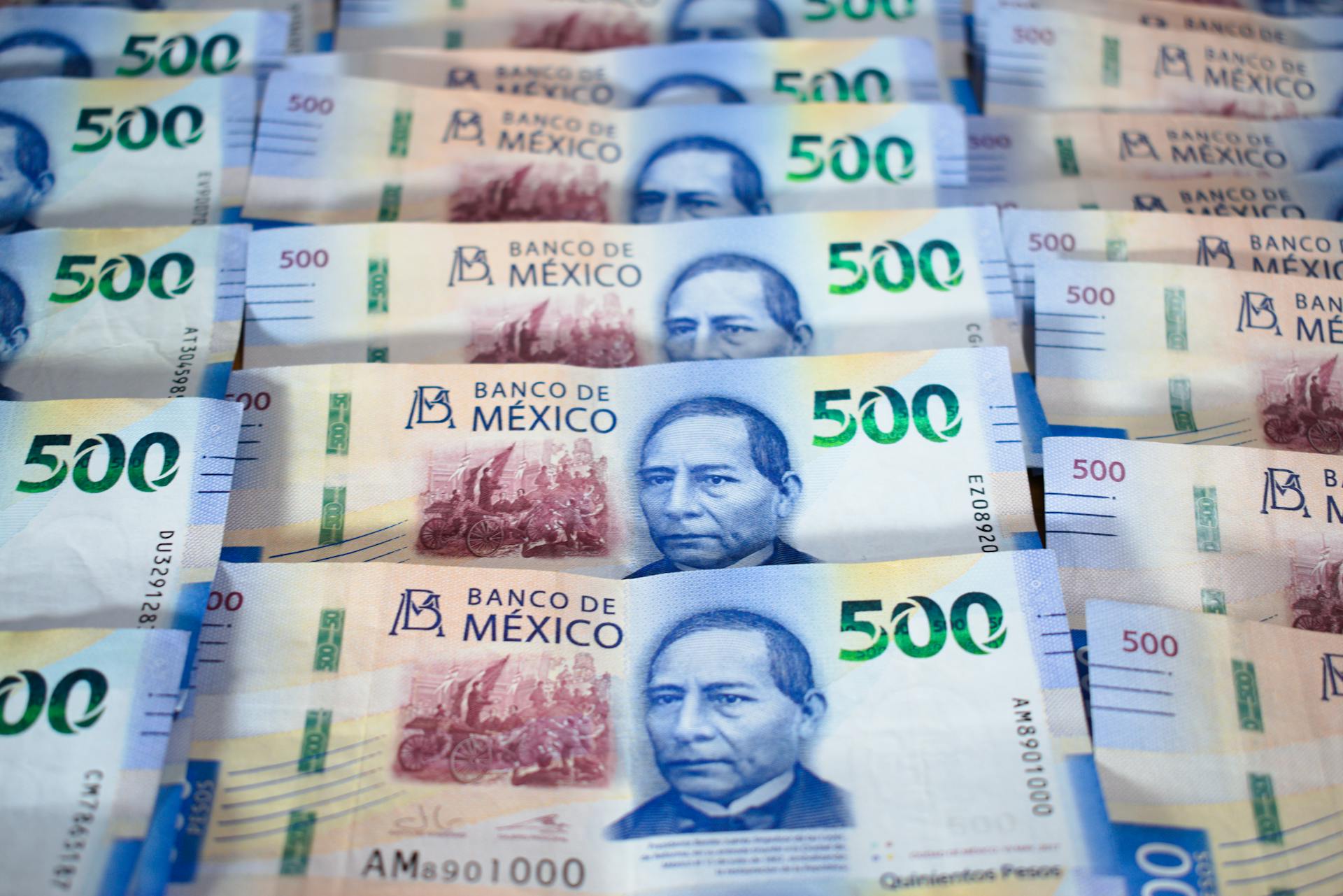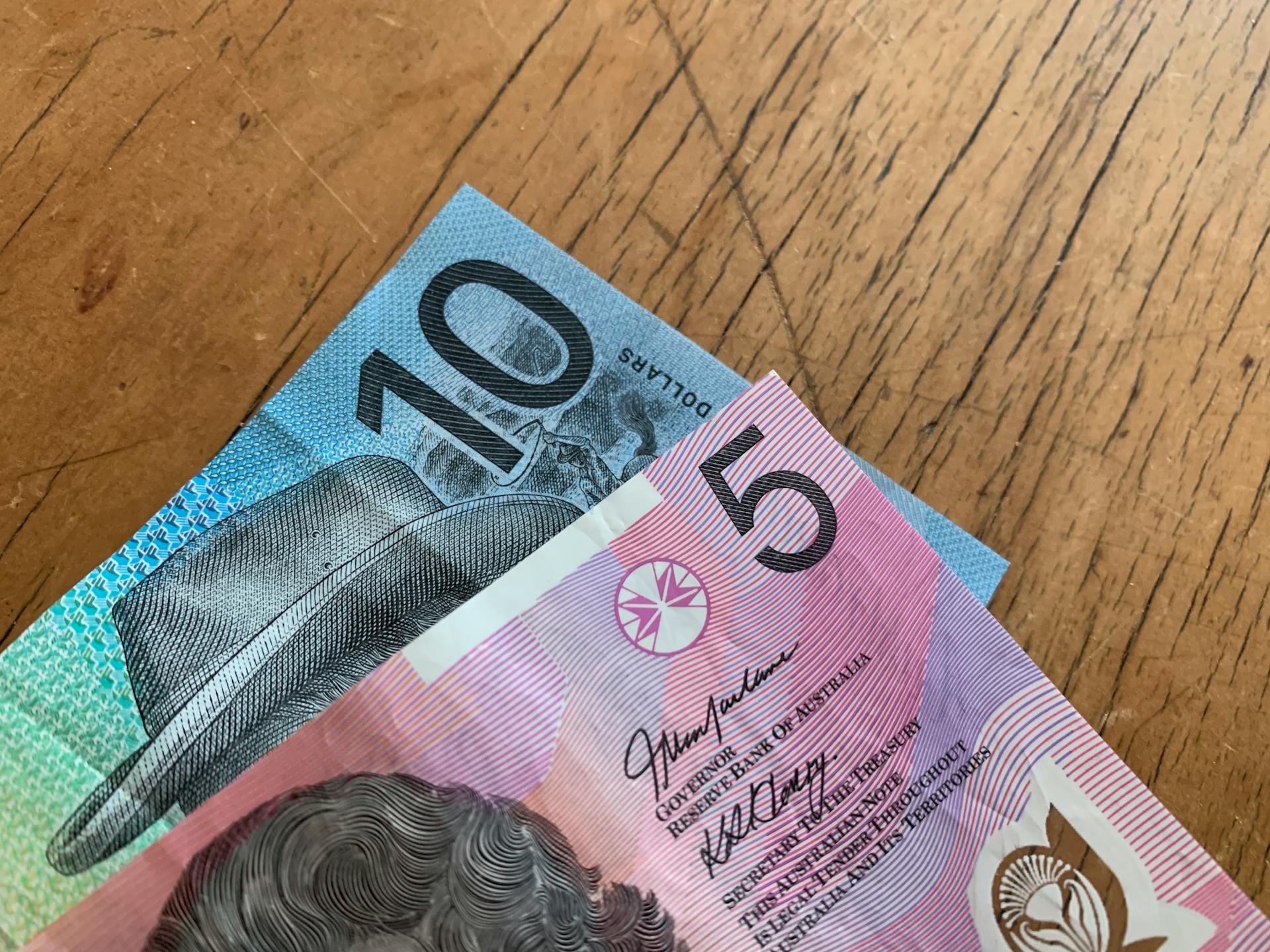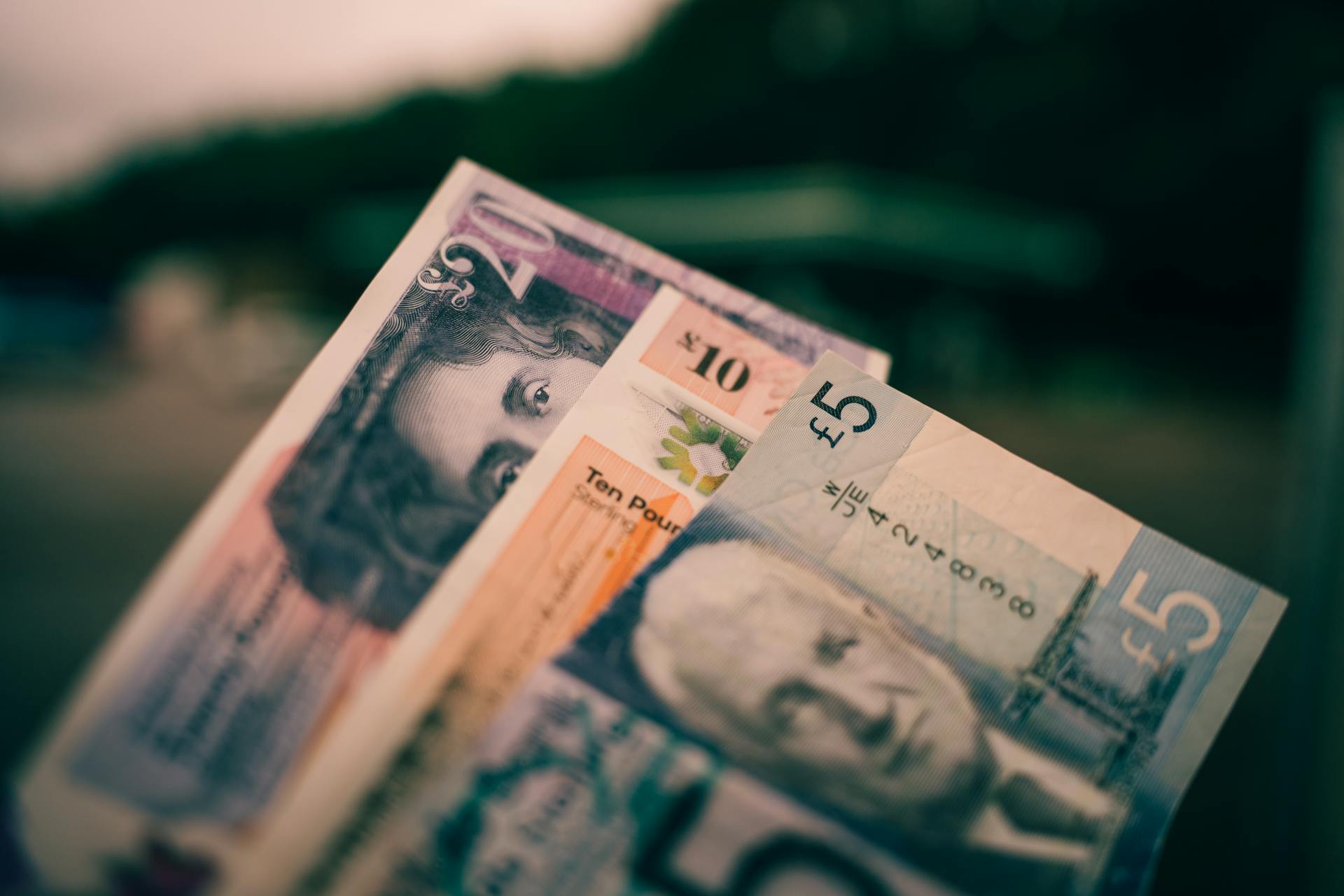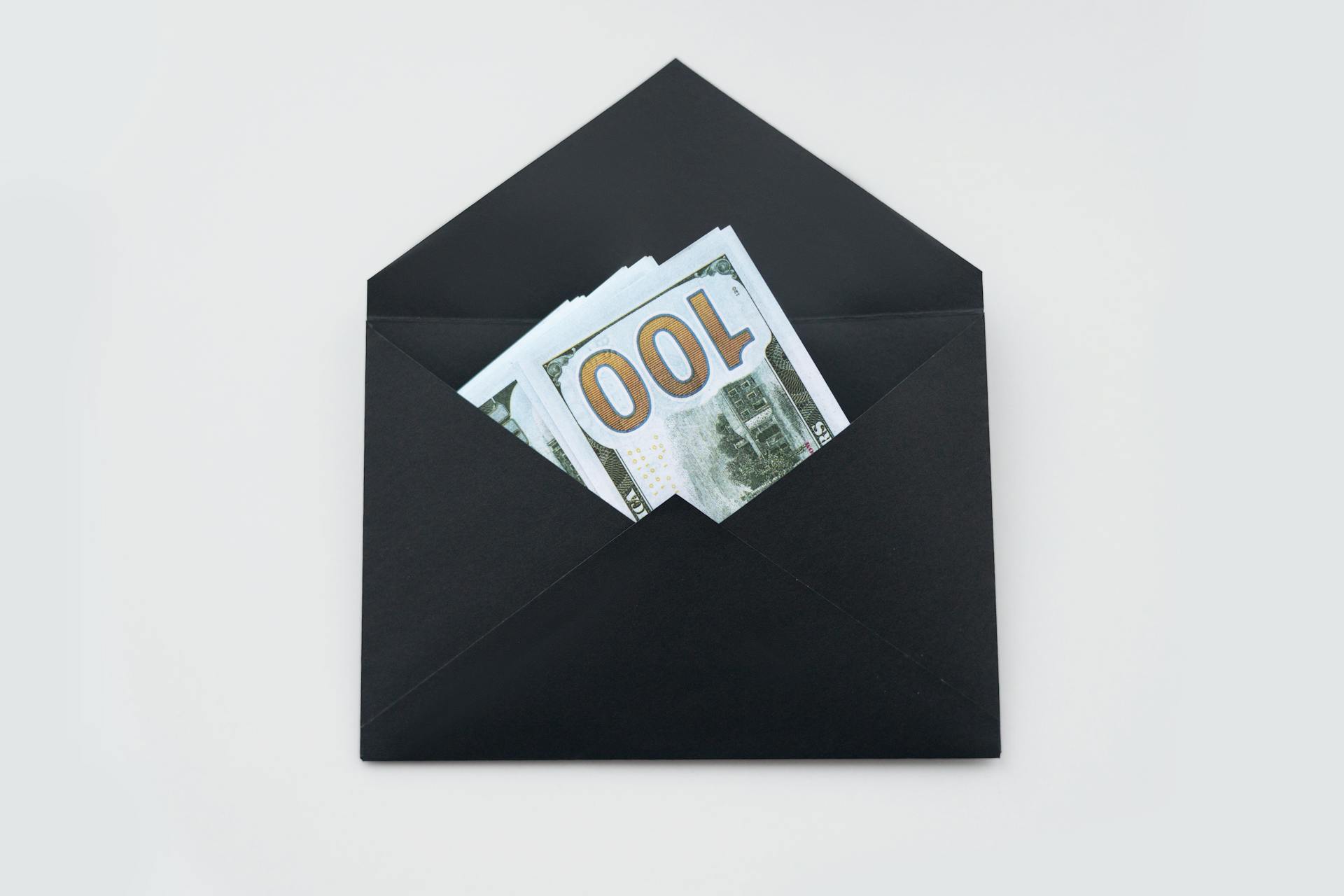
The Japanese yen is a widely traded currency, and its abbreviation, JPY, is an essential part of global markets.
The yen is the third most traded currency in the world, after the US dollar and the euro.
Its importance in global markets can be attributed to Japan's economic influence and its role as a major player in international trade.
The JPY is widely accepted as a reserve currency by central banks around the world, making it a stable store of value.
Discover more: Global Markets React to the Japanese Yen Carry Trade Unwind
Understanding the Japanese Yen
The Japanese yen is the third-most traded currency in the foreign exchange market, accounting for 16.8% of foreign currency trading turnover in a 2019 survey. This is a significant share, but still far behind the U.S. dollar and the euro.
The yen is also a distant third behind the U.S. dollar and the euro as the denomination of official foreign exchange reserves, with the reserves held in dollars exceeding those in yen more than 10-fold as of Q4 2021. This highlights the yen's relatively limited global influence.
The yen's name is a derivative of "en", the Japanese term for circle, or round object that itself is derived from "yuan", a Chinese term for imported silver coins.
A different take: Foreign Currency Convertible Bonds
Pronunciation and Etymology
The name "yen" has a fascinating history, and it's interesting to note that it derives from the Japanese word 圓 (en, [eɴ]; "round"), which borrows its phonetic reading from Chinese yuan.
The Japanese word 圓 was originally used to refer to silver coins that were imported from the Philippines, and it was given the shinjitaiform 円 in reforms at the end of World War II.
Interestingly, the spelling and pronunciation "yen" is standard in English because of how Japanese was pronounced by Europeans around the 16th century. Japanese /e/ (え) and /we/ (ゑ) were both pronounced [je] back then.
This is why Portuguese missionaries spelled them as "ye", and this spelling was later adopted by other Westerners.
History of the Yen
The Japanese yen has a rich history that spans over a century. The yen's name is a derivative of "en", the Japanese term for circle, or round object that itself is derived from "yuan", a Chinese term for imported silver coins.
The Meiji government adopted the yen in 1871, replacing the metal coinage of the Tokugawa shogunate and the patchwork of paper scrip issued by feudal lords. This marked a significant shift towards a standardized currency.
The Bank of Japan (BoJ) was created in 1882 as a central bank and granted sole power to issue currency in 1884, producing its first yen banknote the following year. This was a crucial step in establishing the yen as Japan's official currency.
World War II destroyed the value of the yen, and U.S. occupation authorities after the war imposed a complex web of regulated exchange rates while steadily depreciating the yen against the dollar amid rapid inflation. The yen's value was pegged to the dollar in 1949.
The yen's value was eventually allowed to float in 1973 following the collapse of the Bretton Woods system of fixed currency exchange rates. This marked a significant shift towards a more flexible exchange rate system.
The 1985 Plaza Accord agreement led to the managed depreciation of the U.S. dollar that more than doubled the value of the Japanese yen against the dollar by 1988, from ¥239 to ¥123 per $1. This was a significant boost to the yen's value.
After decades of ensuing deflation, the BoJ has set a 2% inflation target and pursued an aggressive quantitative easing program.
For more insights, see: Charge off Rates for Credit Cards
Understanding
The Japanese yen is the third-most traded currency in the foreign exchange market, accounting for 16.8% of foreign currency trading turnover in a 2019 survey.
It's a distant third behind the U.S. dollar and the euro in terms of official foreign exchange reserves, with the reserves held in dollars exceeding those in yen more than 10-fold as of Q4 2021.
Japan's current account surplus, which stems from its role as a major net exporter, limits the accumulation of yen by foreign central banks.
This surplus is a significant factor in the yen's relatively low accumulation by foreign central banks.
Here's an interesting read: Where to Exchange Us Dollars for Japanese Yen
Currency Basics
The Japanese yen is the official currency of Japan, represented by the code JPY and the symbol ¥.
Locally, it's pronounced "en" in Japanese and often accompanied by its kanji, 円.
The Japanese yen is available in 10 denominations, including six coins and four banknotes.
Return
When you're traveling to Japan, it's essential to know how to return your change in yen. The official Japanese currency is the Japanese yen, represented by the currency code JPY and the currency symbol, ¥.
You'll often hear locals pronounce yen as "en" in Japanese, and it's commonly accompanied by its kanji, 円, in everyday use.
The Japanese yen comes in 10 denominations, but if you want to know more about the specific coins and banknotes, you can check the denomination section for more information.
How to Pay
Paying in Japan can be a bit confusing, but don't worry, I've got you covered.
Cash is still the most widely accepted form of payment in Japan, and you'll often see cash-only signs at small shops and restaurants.
As of 2024, there are many ways to pay in Japan, but cash is still king.
You can use credit cards at larger shops and restaurants, but some places may not accept them.
In fact, as of 2024, the number of ways to pay in Japan has proliferated, making it easier than ever to get what you need.
You might enjoy: Japan Yen to Chf
Fixed Rate to USD
The Japanese yen has had a fixed rate to the US dollar at various points in history. The first fixed rate was set at ¥360 per USD on April 25, 1949, as part of the Bretton Woods system.
This rate was maintained for over 20 years until 1971, when the United States abandoned the gold standard. The yen's value had been artificially kept high due to the fixed exchange rate.
Before the war, the yen traded on an average of 3.6 yen to the dollar, a rate that was significantly different from the post-war fixed rate. The fixed rate was intended to stabilize prices in the Japanese economy.
The yen's value fluctuated wildly after the war, going as low as 600 yen per USD in 1947 due to currency overprinting to fund the war and reconstruction. The official conversion rate was set at 15 yen to the USD when US forces entered Japan in 1945.
In 1949, the peg was adjusted to 270 yen to the dollar, and later to 360 yen to the dollar in 1971. This rate was maintained until the Smithsonian Agreement in 1971, which set the exchange rate at ¥308 per US$.
International Reserve Currency
The International Reserve Currency is a basket of major currencies held by countries as a store of value. The IMF's special drawing rights (SDR) valuation is a key component of this basket.
The SDR is made up of a basket of currencies, including the Japanese yen, which has a share of 8.33% as of 2016. This share has declined from 18% as of 2000.
The composition of official foreign exchange reserves has changed over time. The percental composition of currencies from 1995 to 2022 shows fluctuations in the dominance of different currencies.
Readers also liked: What Is Share Secured Loan
Best Place to Buy
The best place to buy Japanese yen is at a large branch of a national bank, such as Chase, Bank of America, or Wells Fargo.
These banks often have the best rates and minimal fees, making them a great option for buying currency.
You can also buy foreign currency, including JPY, at airports, but be prepared for wider buy/sell spreads due to the convenience factor.
Intriguing read: Japan Central Bank News
Currency Markets and Economy
The Japanese yen, often abbreviated as JPY, has a unique relationship with the US dollar. The average spot rate of JPY per USD can fluctuate significantly over time.
In periods of financial market stress, the yen tends to appreciate in value, making it a safe haven currency. This is due to low domestic interest rates in Japan and the country's financial institutions seeking higher yields overseas.
The yen's safe haven status was challenged in mid-2022, when it slumped to a 24-year low against the US dollar. This was largely due to the Bank of Japan keeping its policy rate near zero while the Federal Reserve raised interest rates to combat high inflation.
A unique perspective: Japanese Yen History
Spot Rates v USD
The spot rate of the yen against the US dollar is a crucial metric in currency markets. The table below shows the monthly average of the U.S. dollar–yen spot rate (JPY per USD) at 17:00 JST.
The yen has been relatively stable against the US dollar, with fluctuations largely driven by global economic trends. The Bank of Japan's monetary policies, such as keeping interest rates low, have also influenced the yen's value.
If this caught your attention, see: Does S Corp Pay Corporate Taxes
Government Intervention in Currency Markets
Government intervention in currency markets can have significant effects on a country's economy. The Japanese government, for instance, intervened heavily in foreign-exchange markets in the 1970s to prevent a rise in the value of the yen.
This intervention was motivated by concerns that a strong yen would hurt export growth and damage the industrial base. The government's efforts, however, were ultimately unsuccessful in preventing the yen's value from increasing.
Market pressures caused the yen to peak temporarily at an average of ¥271 per US$ in 1973. The yen's value continued to rise despite the government's intervention.
The increased costs of imported oil caused the yen to depreciate to a range of ¥290 per US$ to ¥300 per US$ between 1974 and 1976. The yen's value fluctuated significantly over this period.
The re-emergence of trade surpluses drove the yen back up to ¥211 in 1978. This currency strengthening was again reversed by the second oil shock in 1979.
Suggestion: Japan Intervention Yen
Plaza Accord
The Plaza Accord was a significant event in currency markets that had a profound impact on global economies. In 1985, finance officials from major nations signed an agreement affirming that the dollar was overvalued.
This led to a rapid rise in the value of the yen, which rose from an average of ¥239 per US$ in 1985 to a peak of ¥128 in 1988. The yen's value nearly doubled relative to the dollar in just a few years.
The yen continued to rise, reaching a new high of ¥123 to US$ in December 1992. Its value increased even further, hitting a peak of under 80 yen/US$ in April 1995.
On a similar theme: Japanese Yen Rising
Redenomination Proposals
Numerous proposals have been made since the 1990s to redenominate the yen by introducing a new unit or new yen, equal to 100 yen, and nearly worth one U.S. dollar.
The idea of redenomination has been around for decades, but it hasn't happened yet because the yen remains trusted globally despite its low unit value.
For more insights, see: Japanese Yen to New Taiwan Dollar
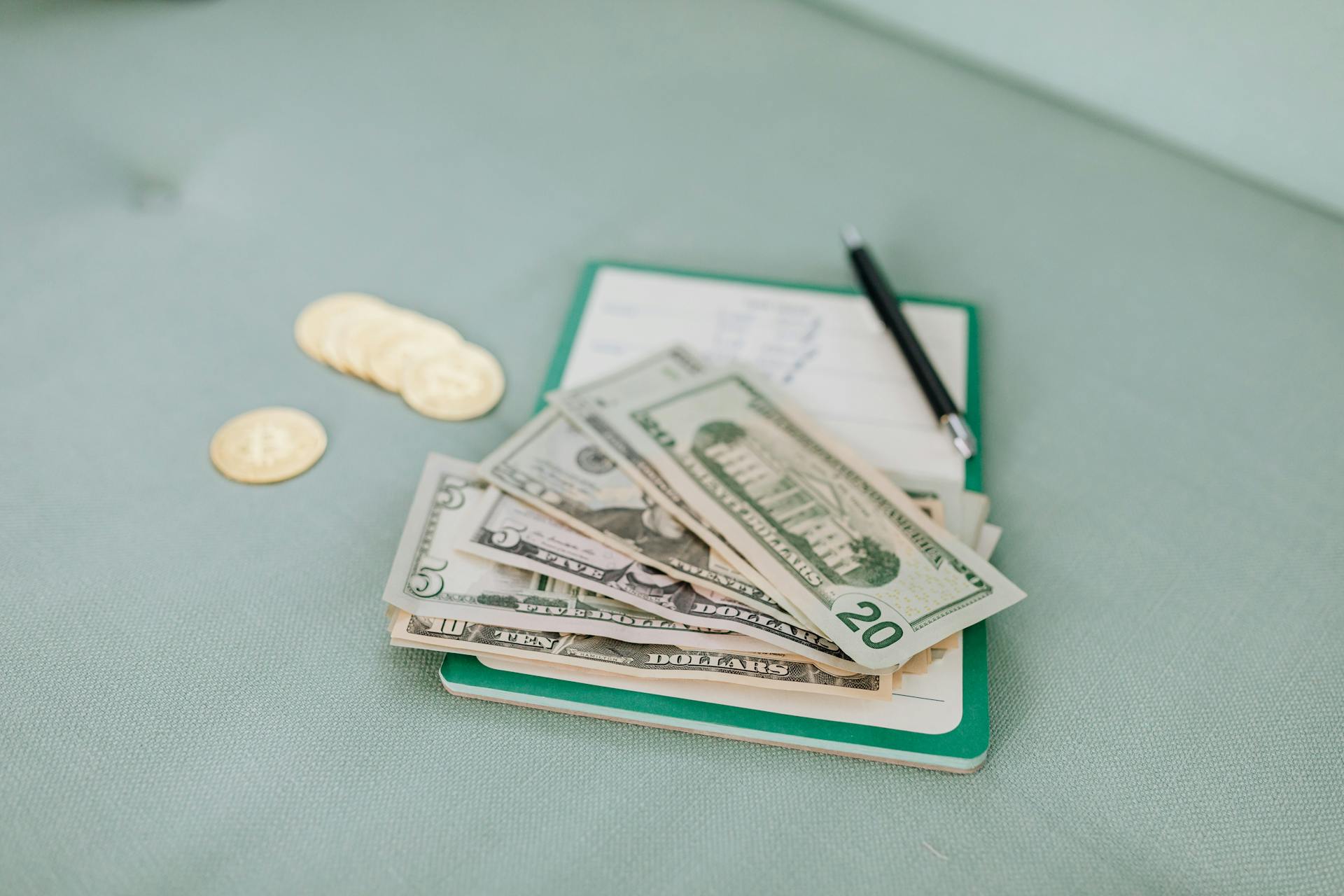
Introducing a new unit or currency would require huge costs, including reissuing new currency and updating currency-reading hardware.
Redenomination would also impact various computer software, which would need to be upgraded to accommodate the new currency.
The costs and complexity of these upgrades have been cited as a reason to postpone redenomination.
JPY Safe Haven
The Japanese yen has long been considered a safe haven, appreciating in value during periods of risk aversion in financial markets.
In times of market stress, the yen tends to gain on the U.S. dollar, a phenomenon that occurs when investment flows reverse.
Low domestic interest rates in Japan have encouraged the country's financial institutions and households to seek out higher yields overseas, a tendency known as the carry trade.
The yen's safe haven status was challenged in mid-2022 when it slumped to a 24-year low against the U.S. dollar.
The Bank of Japan's decision to keep its policy rate near zero, while the Federal Reserve raised interest rates to fight high inflation, contributed to the yen's decline.
Rising consumer prices aggravated by the yen's decline had become a political issue in Japan ahead of national elections.
Take a look at this: A Corporate Financial Manager Trying to Maximize Shareholder Value
Historical Exchange Rate
The yen's value has fluctuated significantly over the years, with a fixed rate of 360 yen to the US dollar maintained from 1949 to 1971.
Before the war, the yen traded at an average of 3.6 yen to the dollar, but after the war, the rate plummeted to as low as 600 yen per USD in 1947 due to currency overprinting.
In 1945, the US forces entered Japan and decreed an official conversion rate of 15 yen to the USD, which later tanked to 50 yen to the USD in 1946 due to ongoing inflation.
The yen's value continued to fluctuate, eventually plummeting to 600 yen to the dollar by 1947, and it wasn't until 1949 that the peg was officially moved to 270 yen to the dollar.
The yen's value has continued to decline in recent years, with the rate falling to upper ¥161 per $1 by July 2024, marking the lowest exchange rate for the yen in 37.5 years.
Japan's trade balance staying in the red and the country's economy lagging behind its peers have been major factors in the yen's decline, with some experts expressing concern about the sharp fall in its value since 2022.
The yen's instability has made it difficult to exchange the currency for Japanese yen at some exchange offices, and experts warn that the yen may continue to depreciate further in the future.
What's Behind the Decline?
The decline of the Japanese yen has been a significant topic in currency markets. One reason is that currency traders have been betting that the Bank of Japan will keep its policy rate near zero despite rising inflation.
The Bank of Japan has indeed kept its policy rate near zero, and in an effort to cap long-term interest rates, it acquired more than half of Japan's government bonds outstanding by June 2022. This move was aimed at promoting growth.
The yen's share of the IMF's special drawing rights (SDR) valuation basket has declined from 18% in 2000 to 8.33% in 2016. This decline is a reflection of the yen's decreased importance in international reserve currency holdings.
The yen's decline has been particularly notable against the US dollar, with it reaching a fresh 24-year low in 2022. This has been attributed to a combination of factors, including the Bank of Japan's monetary policy and the strength of the US economy.
Here is a breakdown of the yen's share of international reserve currency holdings over the years:
The yen's decline has significant implications for Japan's economy, which is heavily reliant on exports. The weaker yen makes Japanese exports more competitive in foreign markets, but it also increases the country's import costs and exacerbates inflationary pressures.
Frequently Asked Questions
Is it JPY or JPN?
The official currency code for the Japanese yen is JPY, not JPN, which is actually the ISO 3166-1 alpha-2 code for Japan.
How do you abbreviate Japanese yen?
The Japanese yen is abbreviated as JPY. This is the standard international currency code for the yen.
Featured Images: pexels.com
